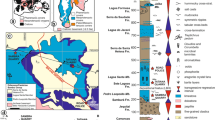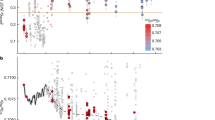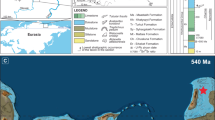Abstract
Marine sediments at ocean margins vent substantial amounts of methane1,2. Microbial oxidation of the methane released can trigger the precipitation of carbonate within sediments and support a broad diversity of seafloor ecosystems3,4. The factors controlling microbial activity and carbonate precipitation associated with the seepage of submarine fluid over geological time remain poorly constrained. Here, we characterize the petrology and geochemistry of rocks sampled from metre-size build-ups of methane-derived carbonate chimneys located at the Amon mud volcano on the Nile deep-sea fan. We find that these carbonates comprise porous structures composed of aggregated spherules of aragonite, and closely resemble microbial carbonate reefs forming at present in the anoxic bottom waters of the Black Sea5. Using U-series dating, we show that the Amon carbonate build-ups formed between 12 and 7 thousand years ago, contemporaneous with the deposition of organic-rich sediments in the eastern Mediterranean, the so-called sapropel layer S1. We propose that the onset of deep-water suboxic or anoxic conditions associated with sapropel formation resulted in the development of intense anaerobic microbial activity at the sea floor, and thus the formation of carbonate chimneys.
This is a preview of subscription content, access via your institution
Access options
Subscribe to this journal
Receive 12 print issues and online access
$259.00 per year
only $21.58 per issue
Buy this article
- Purchase on Springer Link
- Instant access to full article PDF
Prices may be subject to local taxes which are calculated during checkout



Similar content being viewed by others
Change history
05 July 2023
A Correction to this paper has been published: https://doi.org/10.1038/s41561-023-01230-2
References
Solomon, E. A., Kastner, M., MacDonald, I. R. & Leifer, I. Considerable methane fluxes to the atmosphere from hydrocarbon seeps in the Gulf of Mexico. Nature Geosci. 2, 561–565 (2009).
Westbrook, G. K. et al. Escape of methane gas from the seabed along the West Spitsbergen continental margin. Geophys. Res. Lett. 36, L15608 (2009).
Sibuet, M. & Olu, K. Biogeography, biodiversity and fluid dependence of deep-sea cold-seep communities at active and passive margins. Deep-Sea Res. II 45, 517–567 (1998).
Aloisi, G. et al. CH4-consuming microorganisms and the formation of carbonate crusts at cold seeps. Earth Planet. Sci. Lett. 203, 195–203 (2011).
Michaelis, W. et al. Microbial reefs in the Black Sea fueled by anaerobic oxidation of methane. Science 297, 1013–1015 (2002).
Boetius, A. et al. A marine microbial consortium apparently mediating anaerobic oxidation of methane. Nature 407, 623–626 (2000).
Etiope, G. & Milkov, A. A new estimate of global methane flux from onshore and shallow submarine mud volcanoes to the atmosphere. Environ. Geol. 46, 997–1002 (2004).
Cohen, A. S., Coe, A. L. & Kemp, D. B. The late Palaeocene—Early Eocene and Toarcian (Early Jurassic) carbon isotope excursions: a comparison of their time scales, associated environmental changes, causes and consequences. J. Geol. Soc. 164, 1093–1108 (2007).
Teichert, B. M. A. et al. U–Th systematics and ages of authigenic carbonates from Hydrate Ridge, Cascadia Margin: Recorders of fluid flow variations. Geochim. Cosmochim. Acta 67, 3845–3857 (2003).
Kiel, S. Global hydrocarbon seep-carbonate precipitation correlates with deep-water temperatures and eustatic sea-level fluctuations since the Late Jurassic. Terra Nova 21, 279–284 (2009).
Kutterolf, S. et al. Lifetime and cyclicity of fluid venting at forearc mound structures determined by tephrostratigraphy and radiometric dating of authigenic carbonates. Geology 36, 707–710 (2008).
Dupre, S. et al. High-resolution mapping of large gas emitting mud volcanoes on the Egyptian continental margin (Nile Deep Sea Fan) by AUV surveys. Mar. Geophys. Res. 29, 275–290 (2008).
Dupre, S. et al. Seafloor geological studies above active gas chimneys off Egypt (Central Nile deep sea fan). Deep Sea Res. I 54, 1146–1172 (2007).
Dupre, S., Woodside, J., Klaucke, I., Mascle, J. & Foucher, J-P. Widespread active seepage activity on the Nile Deep Sea Fan (offshore Egypt) revealed by high-definition geophysical imagery. Mar. Geol. 275, 1–19 (2010).
Mastalerz, V., de Lange, G. J. & Dahlmann, A. Differential aerobic and anaerobic oxidation of hydrocarbon gases discharged at mud volcanoes in the Nile deep-sea fan. Geochim. Cosmochim. Acta 73, 3849–3863 (2009).
Felden, J. et al. Limitations of microbial hydrocarbon degradation at the Amon Mud Volcano (Nile Deep Sea Fan). Biogeosciences 10, 3269–3283 (2013).
Treude, T. et al. Consumption of methane and CO2 by methanotrophic microbial mats from gas seeps of the anoxic Black Sea. Appl. Environ. Microbiol. 73, 2271–2283 (2007).
Reitner, J., Peckmann, J., Reimer, A., Schumann, G. & Thiel, V. Methane-derived carbonate build-ups and associated microbial communities at cold seeps on the lower Crimean shelf (Black Sea). Facies 51, 66–79 (2005).
Bahr, A. et al. Authigenic carbonate precipitates from the NE Black Sea: A mineralogical, geochemical, and lipid biomarker study. Int. J. Earth Sci. 98, 677–695 (2009).
Naehr, T. H. et al. Authigenic carbonate formation at hydrocarbon seeps in continental margin sediments: A comparative study. Deep Sea Res. II 54, 1268–1291 (2007).
Bayon, G. et al. Multi-disciplinary investigation of fluid seepage on an unstable margin: The case of the Central Nile deep sea fan. Mar. Geol. 261, 92–104 (2009).
Luff, R., Wallmann, K. & Aloisi, G. Physical and biogeochemical constraints on carbonate crust formation at cold vent sites: Significance for fluid and methane budgets and chemosynthetic biological communities. Earth Planet. Sci. Lett. 221, 337–353 (2004).
Teichert, B. M. A., Bohrmann, G. & Suess, E. Chemoherms on Hydrate Ridge—Unique microbially-mediated carbonate build-ups growing into the water column. Palaeogeogr. Palaeoclimatol. Palaeoecol. 227, 67–85 (2005).
Treude, T., Knittel, K., Blumenberg, M., Seifert, R. & Boetius, A. Subsurface microbial methanotrophic mats in the Black Sea. Appl. Environ. Microbiol. 71, 6375–6378 (2005).
Bayon, G., Henderson, G. M. & Bohn, M. U–Th stratigraphy of a cold seep carbonate crust. Chem. Geol. 260, 47–56 (2009).
De Lange, G. J. et al. Synchronous basin-wide formation and redox- controlled preservation of a Mediterranean sapropel. Nature Geosci. 1, 606–610 (2008).
Rohling, E. J. Review and new aspects concerning the formation of eastern Mediterranean sapropels. Mar. Geol. 122, 1–28 (1994).
Schmiedl, G. et al. Climatic forcing of eastern Mediterranean deep-water formation and benthic ecosystems during the past 22 000 years. Quat. Sci. Rev. 29, 3006–3020 (2010).
Feng, D. et al. Rare earth elements of seep carbonates: Indication for redox variations and microbiological processes at modern seep sites. J. Asian Earth Sci. 65, 27–33 (2013).
Schrag, D. P., Higgins, J. A., Macdonald, F. A. & Johnston, D. T. Authigenic carbonate and the history of the global carbon cycle. Science 339, 540–543 (2013).
Acknowledgements
We thank the crews of RV Meteor and ROV QUEST4000 (MARUM, University of Bremen, Germany), and all participants of the BIONIL cruise (M70/2; chief scientist: A. Boetius), for their assistance at sea. We acknowledge Y. Germain, E. Rongemaille, A. Roubi and C. Bassoullet for help in the laboratory at IFREMER and Institut Universitaire Européen de la Mer (I.U.E.M.), respectively. We are very grateful to G. M. Henderson for providing the U–Th spike, and also thank A. Crémière, E. Ducassou, J-P. Foucher, T. Himmler and V. Liebetrau for helpful discussions. This work was financially supported through the ESF EUROCORES project MEDIFLUX, the EU 6th FP HERMES project (GOCE-CT-2005-511234-1), the EU 7th FP HERMIONE project (contract 226354) and IFREMER. Further financial support came from the Liebniz programme of the DFB to A.B. and Max Planck Society.
Author information
Authors and Affiliations
Contributions
G.B., S.D., J.M. and A.B. conceived the project and participated in the BIONIL cruise (RV Meteor). G.B. performed sample/chemical preparation, and wrote the article. G.B., E.P., J.E., S.C. and C.P. analysed the samples. All authors contributed to discussions, interpretation of the results and manuscript writing.
Corresponding author
Ethics declarations
Competing interests
The authors declare no competing financial interests.
Supplementary information
Supplementary Information
Supplementary Information (PDF 294 kb)
Rights and permissions
About this article
Cite this article
Bayon, G., Dupré, S., Ponzevera, E. et al. Formation of carbonate chimneys in the Mediterranean Sea linked to deep-water oxygen depletion. Nature Geosci 6, 755–760 (2013). https://doi.org/10.1038/ngeo1888
Received:
Accepted:
Published:
Issue Date:
DOI: https://doi.org/10.1038/ngeo1888
This article is cited by
-
Magnesium isotopes of chlorite-rich hydrothermal sediments in the Okinawa Trough and indications for Mg cycle
Science China Earth Sciences (2023)
-
A record of seafloor methane seepage across the last 150 million years
Scientific Reports (2020)
-
Seeking a geochemical identifier for authigenic carbonate
Nature Communications (2016)
-
Seep-carbonate lamination controlled by cyclic particle flux
Scientific Reports (2016)
-
Authigenic carbonate precipitation at the end-Guadalupian (Middle Permian) in China: Implications for the carbon cycle in ancient anoxic oceans
Progress in Earth and Planetary Science (2015)



